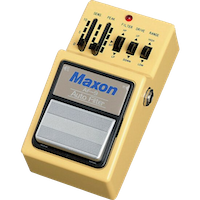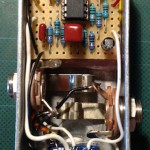Digitech EX-7 Expression factory
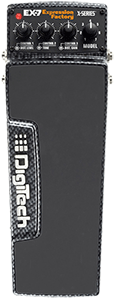
I’m not really sure which category this one belongs in, as it provides lots of different (simulated) effects. But going by the type of effects I mainly use it for, this is the place for it. I realized that I hadn’t used wah for a long time, and was considering taking it off the board and only bringing one to gigs where I knew I’d use it. At the same time, I wanted to expand my arsenal of airy, weird synth-y sounds, and started looking at the EX-7. If it could do a passable wah sound as well as all the other sounds, it might be something for me… It turned out great. Of course, the wah isn’t anywhere near as juicy and organic as the real thing, but it’ll do for the (very few) gigs where it’s called for. The Space Station model is great, while the Whammy model probably won’t get too much use. If I want a lower octave, the Octron is much better. But being able to manipulate the pitch with your foot could come in handy, I suppose. The Uni-vibe model is the weakest, IMO, and didn’t win me over. The leslie sim is another effect that I have better ways to achieve (sticking my Korg G4 after the pedalboard sounds much better, not to mention using my real leslie cab), but if I quickly need to imitate an organ, the EX-7’s TS-9 + leslie sim combination will do a passable impression without having to carry additional gear. The ADA flanger simulation sounds good, but as you can’t control the output level, it tends to lose a little volume.
The pedal doesn’t change the dry tone too much – I did several blind tests, switching the EX-7 in/out from a true bypass loop box with a buffered pedal right after it (to take the cable to the amp out of the equation), and it wasn’t immediately apparent when the pedal was in the chain or not. There was maybe a slight difference, but not enough to cause any worry. I guess it will come down to how much you use it – if it only gets used a few bars per gig, a TB loop box might be in order to get it out of the chain when it’s not in use. If you find more use for it, so it will be activated a lot more, it can just be left as is in the chain.
Dunlop JH-1 wah (modified)
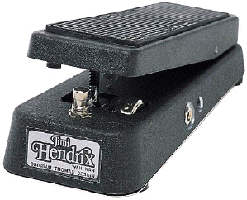
This is a relatively new wah, sporting the rev. G Crybaby circuit board (the JH-1 uses the same circuit board as the regular GCB-95). Or, that’s what it was before I started modding it… I started with the regular Stinkfoot wah mod, and replaced the stock inductor with a red Fasel (the Dunlop one, which comes in most new GCB-95 pedals). The transistors were then replaced with BC109B’s – I happened to have some lying around, and while they do make the pedal sound a little sweeter, it’s not enough of a difference to make me start hunting for NOS transistors. The pedal also has a Fulltone wah pot – the stock pot was on the way out, and I once again happened to have the part in a drawer – and a status LED.
Vox CryBaby wah
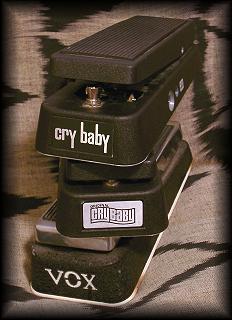
Vintage – manufactured by Jen in Italia. I have no idea what year it might be, but the guy who gave it (yes!) to me played guitar in the late ‘60s and early ‘70s. He approached me one day at work and said that he had some guitar stuff in a box in the basement, and wondered if I might be interested. He then went on to tell me about all the pedals he had used during his “active” period, but he didn’t know their whereabouts. Some of them might be in the aforementioned box, but… All that eventually came out of it was this wah pedal (not bad, mind you) in pretty bad shape. I’ve since replaced the switch (wired for true bypass, naturally) and pot, as well as resolder all connections in an effort to make it a little more dependable. However, there’s still something wrong with the circuit board – it crackles badly with every little flexing, which points to a hairline crack in one of the pcb traces. I need to get that sorted, before I can use it properly.
In the pic, it’s the one on the bottom of the pile (if you haven’t already figured that out). The other two are long gone. The middle one is a 1991 Rev F Crybaby I bought new, which was with me for the longest time, and was the first pedal I ever modified. The top one is a newer Rev G that passed through my hands at some point.
DOD FX25 Envelope Filter
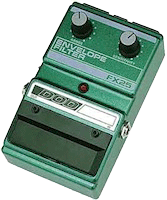
I got this one off a sales ad here in Sweden, not really knowing why (what else is new?). I had just sold off the RoboTalk, and figured I might be able to put this one to use. Or not. Either way, it’s a cool pedal and the deal was more than decent, so I went for it. A while later, I came across another one for cheap in the classifieds, so I bought that one too, and ended up giving it to a bass playing friend who needed a ”Wow! What was that?” effect for a tour. My original one is currently being used on my bass pedalboard.
Anyway, for guitar, the pedal is not as refined as the filter section in the RoboTalk I used to have – where the RoboTalk 1 was smooth and well-mannered, this one is brash, loud and growly. Don’t get me wrong – it is the good kind of growly :). When it sweeps back (as the input signal drops in strength), it is very grainy with a very gargly character. But the hard thing is setting it up right – it is quite hard to find the sweet spot where the pedal is clear enough to not sound muffled, but still will not spend all its time in the highest frequency band. But if you’re prepared to set it up for one guitar (and move the controls slightly when you use it with another one, if it’s slightly louder or quieter), it is well worth the effort. This is an effect you really only can use once or twice each night, in the right band, but not much more. Although I have to restrain myself – the sound when I kick it in is soo cool that I’m tempted to use it far too often…
Maxon AF-9 Auto Filter
While I am partial to the almost brutal snap of the DOD FX25, for that ”What I am” (Edie Brickell and the New Bohemians – look it up, kids 😉 ) tone, something slightly more balanced is in order. In went the AF-9. It seems to do the trick, with very nice and smooth vowel sounds.
As with all envelope filters, it seems to work better with humbuckers, probably due to their slightly more compressed dynamics. Single coils can get a little more snappy, with the filter of course translates into a ”peakier” sound. To help with that, I always run a compressor before the AF-9, to help keep the peaks in check. It might seem a bit counter-intuitive to use an effect that relies on the dynamics to do its thing, and then limit the dynamics going into it… but it really does help keep the filter more in the ”sweet spot” range – not too dark, not too bright.
The latest version of the Maxon AF-9 has been redesigned with two knobs and three toggle switches, but mine is the earlier version with the two sliders and three slide switches (as pictured).
Marshall ED-1 Compressor
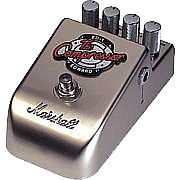
I had a big gig coming up, and needed a good compressor to help me bring my clean sound a little closer to my dirty sounds (overdrive pedals do compress the signal quite a bit). So I built a clone of the grey Ross compressor, and of course it didn’t work properly… (one of these days, I’ll get around to trouble-shooting it – I promise :)) At the same time, I was talking to a friend about compressors for bass – he had a Marshall comp that he was thinking about selling, and I thought I might as well… I modified a Boss CS-3 for him to try, and brought the Marshall home. After a quick spin with it, I realized that I wasn’t going to let him sell the Marshall comp – it only needed a few mods to fit the lower bass frequencies, and then I needed to get another one for myself. What a gem it turned out to be! It was very transparent sounding, with just a slight reduction in the top end, and with some careful dialing I was able to make my clean sound sit perfectly in the mix (the same way the dirty sounds does).
Of course, nothing is perfect… the Marshall uses the hardwire/half-assed/output switching only bypass style, where the circuit input is permanently connected to the input jack. This arrangement can steal a lot of tone under certain (many) circumstances, so it is less than ideal. Also, the Marshall engineers has added a few inductors and ferrite beads in the direct signal path, as well as a capacitor straight to ground, none of which helps the bypass sound. So I’ve (naturally) modified it to true bypass. Sadly, there’s something in the circuit design that makes the modified pedal ”pop” when turned on/off, and no amount of pop fixes (there are a few tricks you can use to reduce that problem) seems to help. I guess these inductors were there as a stopgap fix for what is really a design flaw… Other than that, it sounds great! And when I used it on bass, I never turned it off anyway 🙂
EBS MultiComp
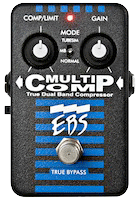
One time, my local music store decided to sell off their ex-demo EBS pedals. So I quickly snapped this MultiComp up, and ended up paying just above half the list price 🙂 This is designed for bass (obviously, being an EBS), and that’s also how I use the pedal. But I also keep hearing how well it works with guitar, so the rest of this text will be focused on that aspect.
First try, just plugging it in and setting it up as I would any other comp, I was not terribly impressed… it was harsh-sounding, with the bass cut and a high-mid emphasis that didn’t sound nice at all. As it turns out, I should have read the manual… 🙂
So here goes: on this pedal, the ”comp/limit” knob sets the compression ratio (rather than the threshold, like on most compressor pedals). The threshold seems to be fixed in normal and tubesim mode, and there’s a switch next to the output jack that lets you adapt the pedal for higher or lower output pickups. Without having seen the schematic, I suspect the active/passive switch simply sets two different threshold levels. So you can experiment with low threshold (compressor kicks in early) and set the compression ratio low, or high threshold (compressor kicks in later) and set the compression ratio higher, for two distinctly different sounds. Also, you have the ”mode” switch to play with… The manual specifically mentions using the ”normal” and ”tubesim” (same as normal, but with added upper mid harmonics) with the comp/limit know set fairly low, and to switch to the MB (multiband) setting if you want more heavy compression. So, quite the opposite of what I did when I first plugged it in, then…
In normal and tubesim mode, you really have to keep the compression ratio quite low, or it will get that upper mid emphasis. Keep the comp/limit knob at around 9 o’clock, though, and it does a great job of keeping the loudest transients at bay (perfect for smoothing out a bass). But for more ”guitar compressor” type sounds (you know, slightly squashed with that ”snap” to the notes and increased sustain), the multiband setting is the way to go. It splits the highs and lows into two separate compressor paths, and inside the pedal you can tweak the threshold setting of the two compressors. Again, I’m guessing here, but it sounds like the MB mode’s stock threshold setting is a bit different from the other two modes. Either way, the MB mode is where I started gelling with the MultiComp. It’s still not that much about adding sustain – you won’t hear it boosting the tail end of the notes the way an MXR Dynacomp does, for instance. It is much more about managing transients, and it does a great job at that. The pedal currently lives on my bass pedalboard, where it is left constantly on 🙂
Xotic SP Compressor
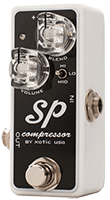
I have owned a few different compressors over the years (and still have most of them), but still hadn’t (haven’t?) found the one. I could never really get the balance right between smooth ”snap” and sustain, and the natural attack of the instrument. This one has a blend control, so you can mix some of that attack back in. Its size also made it a contender for my new pedalboard project, so I decided to give it a go. When I first heard about it, I wondered how they managed to fit the circuit and a regular 9v battery in a Hammond 1590A box – I’ve built a few circuits in that box, and there’s just no way to find room for the jacks and a battery in there. With the pedal in hand, the answer is simple – they didn’t use the 1590A. It looks like that box, but is actually a bit deeper to accomodate the battery. So all you DIYers can breathe a sigh of relief – it’s not just you who can’t fit a 9v battery in that size box 🙂
Soundwise it is very clean. You get three different compression settings (further attack/release time tweaks can be made inside), and while I was afraid I’d miss having a pot for the ”sustain” setting, the three positions seem to be just right. I run it in either low or mid compression mode, with the blend knob at around 1-2 o’clock. So you hear mostly the compressor, with just a little of the original attack mixed in. I have also set the attack time to a slightly longer setting (via the DIP switches inside), to bring out even more of the initial attack. The one grief I have is the transparent knobs – while they look really cool, the novelty quickly wears off, as it is quite hard to see the knob settings at a glance.
Foxrox Electronics Octron
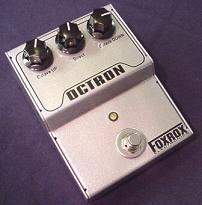
I got whiff of this pedal through my participation on the Harmony Central effects forum, and signed up for one of the initial 100 Octrons being built. After a couple of months I received Octron #26, and I am truly amazed. Dave Fox is an outstanding pedal builder, who always comes up with something that is a little outside of the box. The Octron is no exception – it is essentially two completely different analog octave effects rolled into one box, with the ability to freely mix how much you want to hear of each. As a bonus, it also has a superb preamp/buffer for the regular/dry signal, which only makes the guitar sound bigger without making it that much louder. And then there’s the octave effects…
First off, the octave down works in a similar fashion to the venerable Boss OC-2 Octaver – both use analog frequency dividers to create a lower octave note, and both do not work with more than one note at a time. The difference is that the Octron tracks much better than the OC-2, and if you happen to confuse it (for instance by playing two notes at the same time), it will try to lock on to the strongest pitch, jumping between the two notes in quite an interesting robot fashion. I’m not sure this is what Dave designed the pedal for, but it’s a really cool sound anyway. Other than that, keeping the dry mix fully up and bringing in the lower octave instantly beams you back to the ’80s, when all the cool single-note riffs were played…
The octave up is a completely different affair – once again, it’s an analog octave effect, but much more related to the legendary Octavia than any pitch shifter. It spits and grinds, and sounds downright awesome! Not quite as ”dirty” and ring modulator-ish as a true Octavia, but not far off. And if you want the upper octave to be a little more well-mannered, it will do that too.
I tend to use the pedal either as an octave up screamer – when fed into a low/medium gain overdrive, the Octron takes on a whole new angry personality – or as an octave down unit with the dry signal mixed in. I debated whether the Octron should go in this section or the Distortion/Overdrive/Fuzz section (where my Octavia clone is listed), but it ended up here since it also does a clean octave down. It was – and still is – a toss-up, though 🙂
EBS OctaBass

Used in the bass rig. I usually run it in the ”low range” mode, with the ”normal” pot fully up and the octave about halfway up. This is the best octave down pedal I’ve ever tried on bass (I love the Octron too, but haven’t tried it with bass). It seems to keep track of the notes far longer than the Boss OC-2, which makes it infinitely more useful. It can be used more as a sub-octave filler, part of the core tone rather than a spectacular one-off effect. I don’t miss the 2nd octave down either – the one provided by the OctaBass is just fine.
One feature I must admit I haven’t used very much is the way the pedal is supposed to recognize the bottom note of a chord, and only process that note. But it is good to know that the pedal won’t completely freak out if I happen to throw in a major 3rd on top of the core note. My only niggle with the pedal is that sometimes when I turn it on/off, it gives off a fairly loud ”thump” – it’s not a traditional switch pop, but more as if it picks up a thump at the circuit input and spits it out an octave below 🙂
Oh, and before you ask – the EBS pedals that say ”true bypass” on them actually are. I’ve (of course) actually taken mine apart to verify it… 🙂
Danelectro Fish & Chips EQ
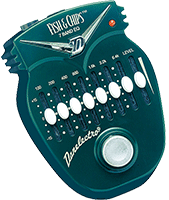
A good EQ pedal is a really good tool to have around, and the Fish & Chips is one of the best. Do not let the cheap price, wonky name and aesthetics fool you – it is dead quiet and works great. The one thing – and it is a fairly large thing – is that plastic case. I don’t see it surviving long, if used and treated as your average stomp box. Also, those jacks have no other support than the solder joints on the circuit board, so if someone steps on the plugs sticking out…
I did use it as a volume booster for solos, and ran it from a 5-way true bypass loop box to turn it on/off. It is currently not in use, but when I need a more transparent boost – and especially if I also want to shape the tone a little – the Fish & Chips will be right there. A good tool to have, as mentioned.
Stinkfoot boosters
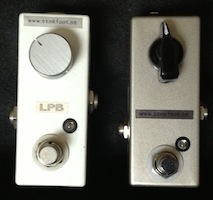
There’s actually three of these around. I was only able to round up two of them for a group shot, but hey… 🙂
The white one is based on the very old Electro-Harmonix LPB circuit, and stuffed in a small box. The LPB circuit is dead simple, and yet very toneful. It runs flat out at all times – the knob controls the output volume, not the gain of the amplifier stage – so it does add a little sag and clipping to the signal. Not the most transparent of boosts, but certainly not without character. I like it!
The silver one is another small size box, this time with a Micro Amp circuit built on veroboard. I used a vero layout by IvIark (thanks!), and you can take a peek inside it by clicking the pic to the left. Tonally, it is a little cleaner than the LPB, and works well as a clean booster after distortion.
The last one (not pictured) uses the Jack Orman ”Mini-Boost” circuit – I actually bought a ready-to-solder circuit board from Jack, and stuffed it in a regular MXR-sized box. It is a little fatter sounding than the LPB, and a good one to boot. Trouble is, I don’t know where it is at the moment…
